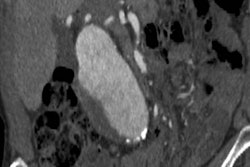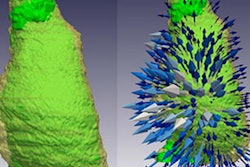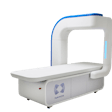
DENVER - An artificial intelligence (AI) algorithm was able to screen for aortic dissection and rupture on CT angiography (CTA) scans with high accuracy -- improving triage efficiency for the conditions prior to radiologist review – in a new study, presented Friday at the Society for Imaging Informatics in Medicine (SIIM) annual meeting.
The research group's proprietary convolutional neural network (CNN) serves as an automated triage tool that can spot CTA scans indicating aortic tears and send them to the top of the radiology worklist. Radiologists can then prioritize the review of these possibly urgent cases, increasing the chance of catching aortic dissection and rupture earlier than they might have otherwise, noted presenter Robert Harris, PhD, of radiology practice Virtual Radiologic in Sunrise, FL.
"We developed an [AI] model capable of detecting both aortic dissections and ruptures, and we implemented it in a high-volume environment and used it to prioritize patients in the clinical setting," he told session attendees.
More efficient triage
Fast and accurate diagnosis is vital for patients with aortic dissection or ruptured aortic aneurysm, two potentially fatal conditions marked by a tear in the aorta. Flagging patient cases most likely affected by either one of these conditions early in the radiology workflow could potentially improve triage efficiency and, ultimately, patient outcomes.
 Robert Harris, PhD, of Virtual Radiologic.
Robert Harris, PhD, of Virtual Radiologic.Seeking to automate this process, Harris and colleagues developed a CNN capable of detecting aortic dissection and aortic rupture on CTA scans without relying on human annotations. The CNN consisted of five layers, each of which contained convolution, max pooling, and dropout functions. Together, these functions enabled the deep-learning algorithm to examine individual 2D slices of CTA scan data and then determine the likelihood of aortic dissection and aortic rupture.
To test the CNN, the researchers obtained data from approximately 800 patients who underwent a chest CTA exam for suspicion of aortic dissection or aortic rupture. Next, they created a JPEG image file for each slice in every set of CTA scans, resulting in a total of 87,479 distinct axial CTA images. They also cropped each slice to display only the centermost region of the image, which contained the aorta.
The group trained the CNN on 90% of this CTA dataset and then used the remaining 10% of the dataset to validate the deep-learning algorithm. It took an average of 23.5 seconds to load and apply the AI algorithm to a single series of CTA scans. CTA data for each patient were deemed positive only when the algorithm determined that 50% or more of the slices indicated aortic dissection or rupture.
Shorter delay times
Overall, the algorithm achieved a near-perfect area under the receiver operating characteristic curve (AUC) for accurate identification of aortic dissection and aortic rupture, when using a threshold of 40 mm for dissection length. The algorithm also achieved a sensitivity of roughly 90% and specificity of almost 95% for both conditions.
| Accuracy of AI algorithm for identifying aortic dissection, rupture | ||
| Aortic dissection | Aortic rupture | |
| AUC | 0.98 | 0.99 |
| Sensitivity | 90% | 88.9% |
| Specificity | 94% | 94% |
The CNN was able not only to predict aortic dissection and rupture using CTA data but also to categorize distinct patient cases based on the predictions, according to Harris.
The researchers subsequently integrated the CNN into their image triage system for a live run. The algorithm has not yet been cleared by the U.S. Food and Drug Administration (FDA), but its tasks fall under the classification of "quality improvement" and could thus be implemented into the workflow without the need for patient consent, he noted.
The team found that the CNN was able to identify about 88% of the patients with an aortic dissection and all of those with an aortic rupture. The sensitivity was 87.5% for aortic dissection and 100% for aortic rupture; the specificity for both conditions was 96%.
The group also discovered a statistically significant association between false positives for aortic dissection and older age as well as male gender (p < 0.0001). In addition, false-positive cases had a higher rate of aortic aneurysm, a condition that may increase the likelihood of dissection or rupture (p < 0.0001).
What's more, one of the main clinical implications of applying the CNN was that it more than halved the amount of time it took for a radiologist to review high-priority patient cases.
| Effect of using an AI algorithm to prioritize review of aortic tears on CTA | ||
| No AI algorithm | AI algorithm | |
| Time before high-priority cases were reviewed by a radiologist | 11 minutes | 4.4 minutes |
This workflow provides a simple and lightweight method of screening chest CTA exams for aortic dissection and aortic rupture, allowing for more efficient triage of patients, Harris noted.
Looking ahead, the researchers plan to continue training their CNN on new data and retrain the CNN using the false positives and false negatives from the original validation dataset, allowing it to adjust for systematic errors. They also hope to expand the scope of the deep-learning algorithm to identify aortic dissections on precontrast and abdominal CTA data and not just on contrast chest CTA data.
"This workflow can be expanded to other modalities and pathologies; we are working on using it for intracranial hemorrhage, pneumothorax, and pulmonary embolism," Harris added. "And we are continuing work on other similar AI models at the same time."



















